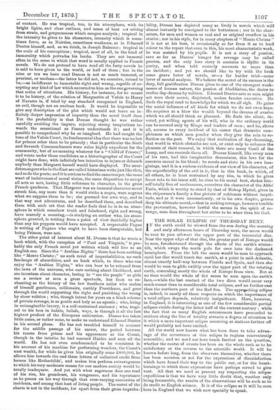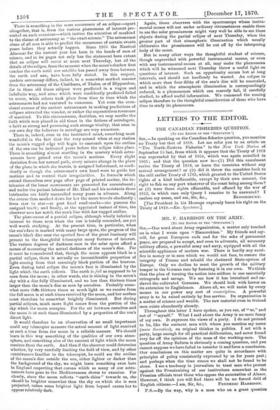THE SOLAR ECLIPSE OF THURSDAY NEXT.
IF the earth could be viewed from the sun during the morning and early afternoon hours of Thursday next, the moon would be seen to pass athwart the upper part of the terrestrial disc. Near the upper edge of that disc, the greater part of Europe would. be seen, foreshortened through the effects of the earth's winter- tilt, which sways the north pole far over into the darkenedi hemisphere. From the left the moon would be seen to approach. until her disc would touch the earth's, at a point in mid-Atlantic, almost exactly half-way between Florida and Spain, and then she would be seen to glide swiftly over the upper part of the rotating earth, concealing nearly the whole of Europe from view. But at no time would the whole of the moon be seen upon the earth's face,—while the last contact of the two discs would occur very much sooner than in considerable total eclipses, and no further east than the northern part of the Red Sea. The apprylaching eclipse, is, indeed, in nearly all those respects on which the importance of a total eclipse depends, relatively insignificant. Here, however, in England, it is interesting as one of the few considerable partial eclipses visible during the latter half of the current century ; while the fact that so many English astronomers have proceeded to. stations along the line of totality attracts a degree of attention to it which a more important eclipse occurring at stations farther of would probably not have excited.
All the world now knows what has been done to take advan- tage of the occurrence of this eclipse in regions conveniently accessible ; and we need not here touch further on the question, whether the course of events has been on the whole such as to be satisfactory or the reverse to the scientific world. It will be known before long, from the observers themselves, whether there has been occasion or not for the expressions of dissatisfaction which have found their way to the public ear, or for the heart- burnings to which those expressions have perhaps served to give vent. All. that we need at present say respecting the eclipse expeditions is that we have very little doubt that, weather only being favourable, the results of the observations will be such as to do credit ro English science. It is of the eclipse as it will be seen here in England that we wish now specially to speak.
There is something in the mere occurrence of an eclipse—apart altogether, that is, from the various phenomena of interest pre- sented on such occasions—which invites the attention of mankind to the claims of astronomy as " the exact science."' The astronomer alone of all men is able to predict the occurrence of certain events years before they actually happen. Since 1865 the Nautical Almanac for the current year has been in the hands of men of science, and in its pages not only has the statement been extant that an eclipse will occur at noon next Thursday, but all the details of the eclipse, from the moment when the moon's shadow first touches the earth until our satellite has passed away from between the earth and sun, have been fully stated. In this respect, modern astronomy differs, indeed, in a somewhat marked manner from the astronomy of the Chaldeans, of Thales, or of Hipparchus, for in those old times eclipses were predicted in a vague and indefinite way, and some which were confidently predicted failed to occur, while others took place from time to time which the astronomers had not ventured to announce. Yet even the occa- sional success of the ancient astronomers in making predictions of eclipses attracted the wonder, or rather the superstitious reverence of mankind. To this circumstance, doubtless, we may ascribe the faith which men placed in old times in the fictions of astrologers, a faith so strong and possessing such strange vitality, that even in our own day the believers in astrology are very numerous.
There is, indeed, even to the instructed mind, something most wonderful in the fact that the very second when at any station the moon's rugged edge will begin to encroach upon the outline of the sun can be indicated years before the eclipse takes place. There is something almost startling in the mastery which astro- nomers have gained over the moon's motions. Every slight deviation from her normal path, every minute change in the place of the plane in which she travels, is assigned beforehand, as confi- dently as though the astronomer's own hand were to guide her motions and to control their irregularities. In formulae which extend themselves over page after page of printed matter, the in- tricacies of the lunar movements are presented for unravelment ; and under the patient labours of Mr. Hind and his assistants those intricacies are fairly unravelled many years in advance. Along the course thus marked down for her the moon travels obediently ; from star to star—as past fixed road-marks—she pursues the assigned track ; and finally, at the appointed instant of time, the observer sees her notch the sun's line with her rugged outline.
The phenomena of a partial eclipse, although wholly inferior in interest to those seen when the sun is totally concealed, are yet well worth studying. At the present time, in particular, when the sun's face is marked with many large spots, the progress of the moon's black disc over the spotted face of the great luminary will present to the thoughtful telescopist many features of interest. The various degrees of darkness seen in the solar spots afford a means of measuring the actual darkness of the moon's disc. For it must be remembered that, though the moon appears black in a partial eclipse, there is actually no inconsiderable proportion of light coming from that seemingly black portion of the heavens. Even during total eclipse the moon's face is illuminated by the light which the earth reflects. The earth is fall as supposed to be seen from the moon ; in other words, she is shining in the moon's sky with a disc fully illuminated, and no less than thirteen times larger than the moon's disc as seen by ourselves. Probably some- what more thita thirteen times as much light as we receive from the full moon is at such times received by the moon, and her surface must therefore be somewhat brightly illuminated. But during partial eclipses, much more light comes from the portion of the sky which the moon occupies. For the air between ourselves and the moon is at such times illuminated by a proportion of the sun's direct light.
It would therefore be an observation of no small importance could any telescopist measure the actual amount of light received at such a time from the moon in a reliable manner. We should learn in this way something of the qualities of our own atmo- sphere, and something also of the amount of light which the moon receives from the earth. And then if the observer could determine whether, by very carefully limiting the field of view, and by other contrivances familiar to the telescopist, he could see the outline of the moon's disc outside the sun, either lighter or darker than the background of the sky, we might learn something even here in England respecting that corona which so many of our astro- nomers have gone to the Mediterranean shores to examine. For clearly, since the moon reflects " earth-shine " towards us, she should be brighter somewhat than the sky on which she is seen projected, unless some brighter light from beyond causes her to appear relatively dark. Again, those observers with the spectroscope whose instru- mental means will not under ordinary circumstances enable them to see the solar prominences might very well be able to see these objects during the partial eclipse of next Thursday, when the greater part of that atmospheric illumination which usually obliterates the prominences will be cut off by the interposing body of the moon.
But in many other ways the thoughtful student of science, though unprovided with powerful instrumental means, or even with any instrumental means at all, may make the phenomena which will be witnessed next Thursday throw a useful light on questions of interest. Such an opportunity occurs but at long intervals, and should not heedlessly be wasted. An eclipse in which more than four-fifths of the sun's disc will be concealed, and in which the atmospheric illumination is correspondingly reduced, is a phenomenon which can scarcely fail, if carefully studied, to afford useful information. We commend the coming eclipse therefore to the thoughtful consideration of those who have time to study its phenomena.







































 Previous page
Previous page